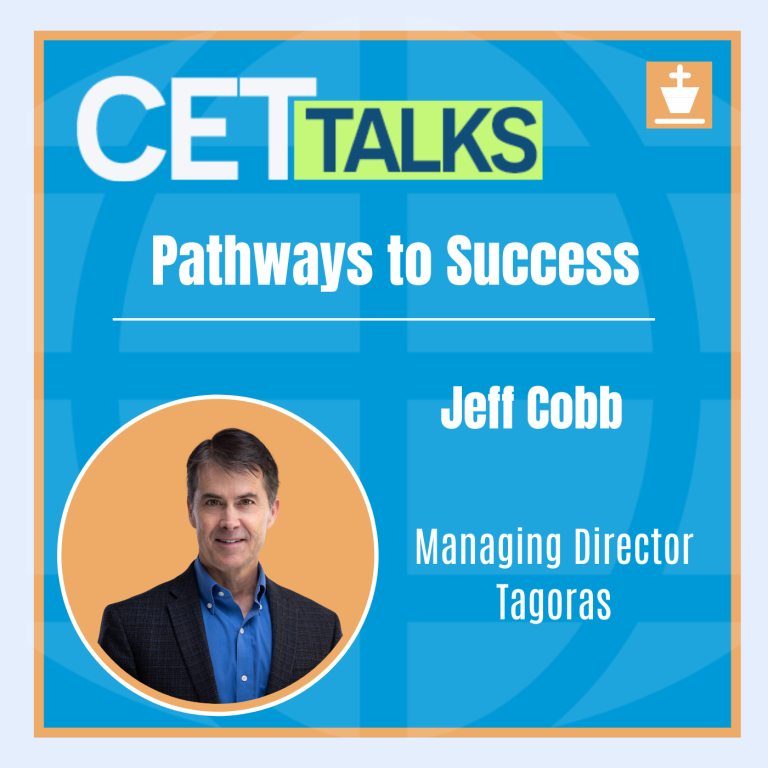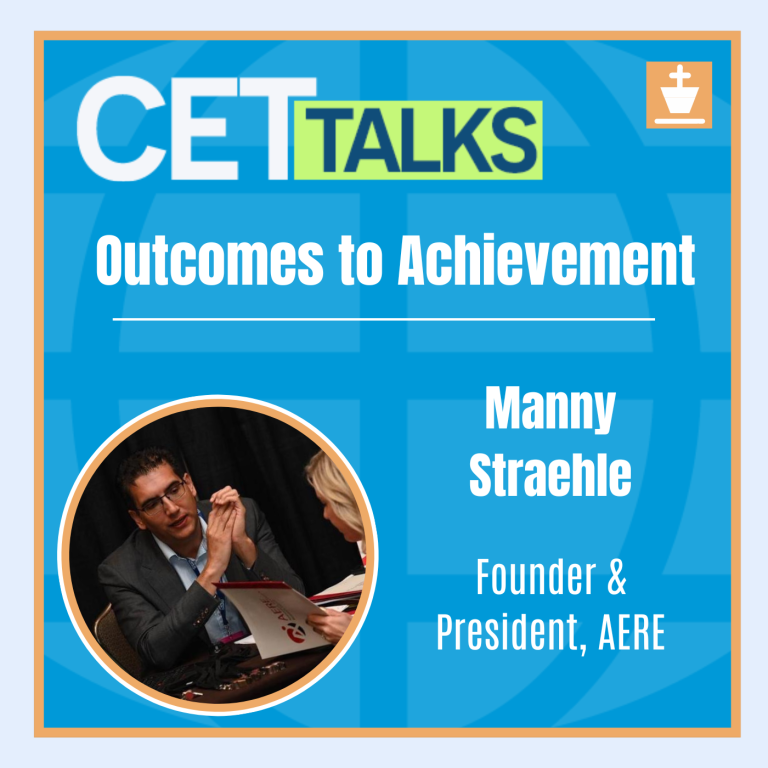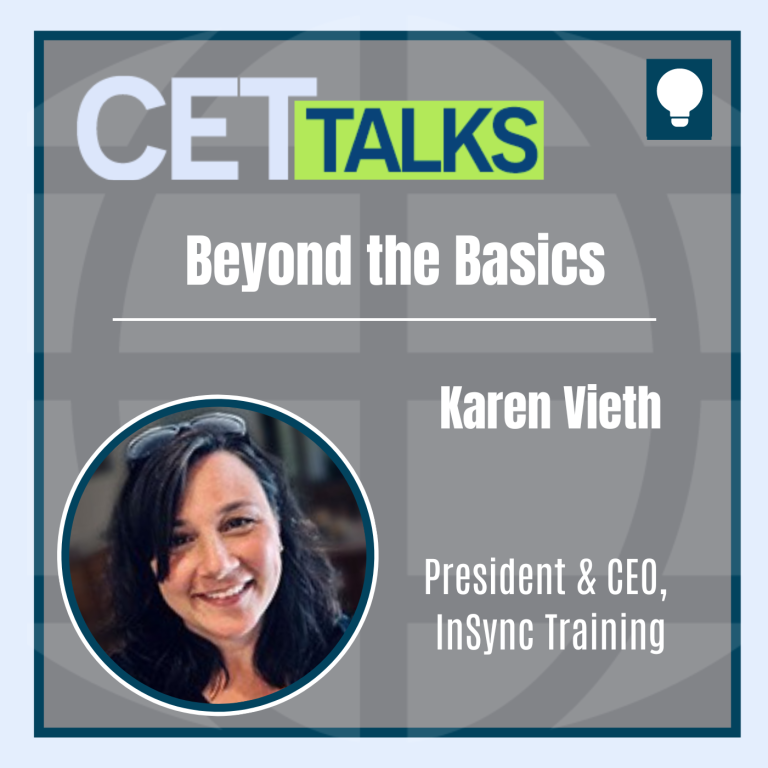Episode 10
.
CET Talks: Accreditation, Learning and Leadership
Episode 10
OCTOBER 17 2023 . 32 MINUTES

Implementing Digital Badges: Engaging Learners and Enhancing Retention
Randy Bowman, Interim President and CEO of IACET, and co-host, Mike Veny, CEO of Mike Veny, Inc., an IACET Accredited Provider, interview Dr. James E. Willis, Professor at the University of Indianapolis, and Meghan Conan, Program Manager of Live Training at ASTM International, as they discuss digital badges. Discover what digital badges are and their importance for training providers. Dr. Willis and Meghan also discuss security considerations, accessibility, and the role of IACET in the digital badging ecosystem. They also share their thoughts about what a world that learns better could look like with wider digital badge adoption.
Listen to the Podcast

Welcome to CET Talks, the International Accreditors for Continuing Education and Training’s podcast, where we convene thought leaders in the continuing education and training ecosystem to share ideas, research, best practices, and experiences that promote the creation of a world that learns better. Your hosts are Randy Bowman, Interim President and CEO of IACET, and certified corporate wellness specialist Mike Veny.
Randy Bowman, Interim President and CEO of IACET, and co-host, Mike Veny, CEO of Mike Veny, Inc., an IACET Accredited Provider, interview Dr. James E. Willis, Professor at the University of Indianapolis, and Meghan Conan, Program Manager of Live Training at ASTM International, as they discuss digital badges. Discover what digital badges are and their importance for training providers. Dr. Willis and Meghan also discuss security considerations, accessibility, and the role of IACET in the digital badging ecosystem. They also share their thoughts about what a world that learns better could look like with wider digital badge adoption.

Transcription
Host: Welcome to CET Talks, the International Accreditors for Continue Education and Trainings podcast, where we convene thought leaders in the continue education and training ecosystem to share ideas, research best practices, and experiences that promote the creation of a world that learns better. Enjoy the episode.
Randy Bowman: Hello, and welcome to CET Talks. My name is Randy Bowman, and I am here with my co-host, Mike Veny, a certified corporate wellness specialist and, and CEO of an IACET- accredited provider. Welcome, Mike.
Mike Veny: Hi, Randy. And hello, everyone. I am the CET Co-host. Randy, before we get started, I wanted to tell you something. During the pandemic, I actually got a little badge from a certification that I got, that I was a certified virtual presenter. I got to put this little badge on my website, and I don’t really know if it meant anything, but I just wanted to share that with you.
Randy Bowman: That’s awesome. It’s always great when we can give our learners some kind of credentials, some kind of sticker to let them know that they’ve achieved something.
Mike Veny: Yes, we like stickers, and today we’re going to be talking about something much bigger than stickers. Actually, this is a very important topic that I’m excited for a lot of information to cover. We’re going to be talking about digital badging and digital credentials, and we have two incredible guests with us. Dr. James E. Willis, he was introduced to open digital badges at Purdue University when he worked as an educational assessment specialist in information technology. He later worked on the MacArthur Foundation grant as a research associate and project coordinator for open digital badges in higher education in the Center for Research on Learning and Technology at Indiana University. Amongst other things, he’s gotten to work with IACET, and during his time he also coordinated with the Information Technology Certification Council (ITCC) to produce badging as a taxonomy. He’s been published in journals like the Journal of Adolescent and Adult Literacy and EDUcause with his work. We also have Megan Conan on the show. Megan is the Program Manager of live training at ASTM International. Megan holds a Master’s degree in Adult Education and Training from the University of Phoenix and a Bachelor’s degree in Business Administration and Human Resources Management from Immaculata University; I don’t know if I pronounced that. She is a member of several professional organizations, including the Project Management Institute, the Association for Talent Development, Environmental Bankers Association, and is also active on the IACET Energy Advisory Board. James and Meghan, welcome to our show.
Meghan Conan: Thank you so much for having us.
Dr. James Willis: Yep, thanks for having us.
Mike Veny: I’d like to get started with a question that is on a lot of our listeners’ minds. What is a digital badge, and why are they important looking forward?
Dr. James Willis: I’ll start with that. An open digital badge is a digital artifact that exists that allows organizations to showcase credentials for people who have done something to earn that badge. Just like badges have been given for thousands of years in human history, an open digital badge allows earners to showcase what they have learned, what they have achieved, and various other credentials. The sky really is the limit, to use the old cliché. Megan?
Meghan Conan: I think you’re spot on there. It’s digital and verifiable. I think that’s important recognition of an achievement for learning. In today’s digital world, being able to find and to verify training rapidly, rather than faxing and digging through files and paper certificates; it makes it a lot easier for folks to prove they’ve got a skill or taken a training.
Mike Veny: Why should training providers be looking into issuing them?
Meghan Conan: As a training provider with ASTM International, I can say we looked into it when we made the decision to move to sharing digital badges for some of our course content. We were looking for verifiability, especially now that it’s a global market and with virtual training. We have folks overseas, and they love the verification of a digital credential. A lot of employers would look to see, do you have this training? And they can very easily click a button and see exactly what digital badges an employee might have. Our instructors in our organization got digital badges as approved instructors, and they love it. They can share it on their emails and on their LinkedIn, saying they are an approved ASTM instructor. They can share that achievement easily.
Dr. James Willis: We used to be in the Wild West of badges, and we’re emerging out of that Wild West at this point. There’s an emergent body of literature that surrounds badges. It’s pretty well documented what works, what doesn’t. Training providers can go through and examine that literature and take training and do a number of things related to badges and now be on firmer footing, as far as what works and what doesn’t. At this point, it’s not as revolutionary. It’s still fairly novel, but with the social media, is firmly entrenched. It’s not going away, particularly for younger people who are going through the educational system now, who are going to be tomorrow’s employees; this is going to be an expectation. Being able to continue one’s education is going to be absolutely critical in the next 20, 30 years of work. What that will look like 20, 30, 50 years from now is anyone’s guess, particularly with things like generative AI, but being able to constantly renew one’s skills, one’s abilities, is going to be critical to the working world and professional life, as much as it has been in the past. I think that’s only going to get exponentially more important.
Randy Bowman: You mentioned the word ‘verifiable’, and then in the same breath we heard a little bit about generative AI. How secure are digital badges? How can we know that one hasn’t been generated by some AI and given out? What are the things we need to be thinking about around those?
Dr. James Willis: Badges, in terms of verifiability, are as reliable as anything when it comes from organizations who issue badges and badging providers. There’s a lot of good faith effort in the field now, and I’ve not seen a compelling example of something that has been falsified through artificial intelligence. It’s not to say it’s not possible, it’s not to say that it hasn’t been done; it’s just that I’m not familiar with any examples. Now, that being said, badges function like other forms of trust mechanisms; you can trust them, but you also need to verify them. When it comes to verifying a person’s credentials, there needs to be due diligence, no matter what the credential is. The other thing I would mention, too, is there’s technology behind badges. Now, some providers offer a blockchain type of environment where using blockchain, just like with cryptocurrencies and other forms of technology, there is verifiability that is built into it and, for all intents and purposes, you’re not able to hack it. People are not able to change that ledger. It is reproduced continuously 24/7. If a badge becomes something that is absolutely necessary for someone’s success and for being able to verify that credential, then the use of blockchain technology is really something that is very much needed behind that technology.
Randy Bowman: One of the things that makes a digital badge, I would say, unique from say, a paper certificate, is this ability to embed the verification straight into the credential itself. For listeners who might not understand this term, what is ‘metadata’? How do they get that embedded into the graphic? And then more importantly, if I get one of these digital badges, how do I read that information to verify the data?
Meghan Conan: That’s a great question. I think one of my favorite things I was ever told in my badging journey about metadata is that it’s just data that describes other data, which I found to be both helpful and incredibly unhelpful, at the same time. But, metadata is a structured reference data that describes the attributes of the badge and the parts that are important, the key components of it. It was definitely one of the most important things when you’re looking at digital badging and digital badging strategy. The metadata for us was the core, the most important piece to have in there.
Dr. James Willis: I can say it is also important to note with metadata, that with what we call an ‘open digital badge’, it has to conform to certain standards, in terms of, does it provide evidence or is there criteria. There are various other components that make up a set of metadata, that then allow this digital artifact to be called an ‘open digital badge’. When it comes to embedding, and that sort of thing, technologically what’s going on is that information is being embedded into an SVG or a JPEG file. More often than not, people who issue badges don’t need to worry because open digital badge providers have all that technology working on the backend. As an instructional designer, you can go in, simply fill in the data fields, and then use the images to embed the metadata inside of it. That’s not something that your average user is going to have to worry about. Actually, I think that highlights one of the big problems with badges; they’re really easy to issue and that makes it so that organizations get really out of hand with this. They start issuing badges for everything and that immediately causes some very serious problems. I’m probably jumping ahead of myself here, but in terms of metadata, it’s important to note that in order for it to be an open digital badge, it has to conform to certain pieces of data.
Mike Veny: I just held up a green little certificate that I carry in my pocket. This is a dollar. You can’t see this if you’re listening to this. I was actually just thinking that years ago people were worried about counterfeit money. They still are, but I remember when online banking became really big, people were wondering if it was legit, and now it’s something that we do all the time. We use debit cards and PayPal and stuff like that. That’s what I’m getting out of this. It’s very similar in the sense to currency, but a question for one or the both of you is how do digital badges impact accessibility to learning or make learning more accessible? Now, I just want to say what I mean by that, because when we talk about accessibility, we’re talking about two different things. Sometimes we’re talking about people with disabilities and making life more accessible for them, but also certain communities of people who might not have access to higher education, and stuff like that.
Meghan Conan: I think one of the beauties of digital badges across the board is the fact that they’re shareable. You’re not just getting a certificate that you’re keeping to yourself, you’re able to share that out. Going back to the metadata that we just talked about, you’re linking information. You are sharing something, a way to find new training, new learning. If someone has a skill that I’m envious of—say James is an expert cheeseburger maker and he has a digital badge for that, and I want to learn how to make cheeseburgers—look, I can now find that training through him rather than searching. You can build skills based on people you admire from what they’ve shared, people in the similar job track or in a job track that you might be looking to advance into.
Dr. James Willis: I think that’s excellent. A couple of things that I wrote down as Megan was speaking gave me some ideas about how to approach this. One of the things that’s fascinating about badges is when they go out into the wild, the market sort of determines what’s valuable and what is not. Meaning that, for people who earned a badge, and it goes on to one of their social media platforms, if it’s something that others see that they’re like, “Wow, that’s really cool. I want to do that,” then that builds an inherent worth inside of the badge. That makes it not only more public for the organization, but also for people who are earning it. It creates this sort of market value on the inside. The other thing, in terms of accessibility, is that these file formats, these forms of technology, work really well on mobile devices. Even if there are communities of people who don’t have laptops or PCs that are readily available, many people have some form of mobile device. Badges can be earned and shared and shown on mobile devices, which is actually really helpful when it comes to going to a workplace. If you’re able to produce a QR code that links back to a badge, that shows direct accessibility and something that many people have in their pockets, anyway. Another thing that I thought about—I wanted to go back to your example of holding up money—is that after President Nixon took us off of the gold standard in 1971, the dollar, the $10 note, the $20 note, etcetera, has inherent value as it’s based on belief. So, instead of being tied to gold, it then became an issue of belief. Badges hold value in the belief that people have about their inherent value, and about that value that is then created within communities of learners and communities of operators, who both see the badge but also interact with the badge. I think there’s a connection there with how our fiat currencies work today. That value is built into the belief system.
Randy Bowman: That that’s definitely deep. The philosopher in James is coming out. So, we’ll talk a little bit more about that in just a few minutes, I think. Megan, you have implemented a digital badging credential in your own training programs. Can you share your experience in implementing that? You gave us a few examples of how your organization has adopted them, but just walk us through, what was that like? What was the transition like? How’s it going?
Meghan Conan: We decided digital badges sounded really cool back in about 2014, 2015, and decided we were going to jump in on that. We started our process of just figuring it out on our own and digging through things. Then, luckily, we stumbled upon training that helped give us another direction. Unfortunately for me, by the time I took training, I had already developed our strategy and plan, so we actually went back and revised it. One of my key pieces of advice for anyone looking to get into that journey is strategy. Strategize before you even touch a system or a platform or think about the badge that you want to do. We have a large training program at ASTM. We have over 600 courses, and I’m going to steal James’ term that I think now needs to be coined officially. We didn’t want to ‘bro badge’ it, and just give out badges for every course that we had, because there wasn’t a measure of worth behind it. We felt they would lose their value if there were 600 badges for every single hour-long course that we had. What we did was decide to give them on a program basis; the energy industry is one of our largest sectors. We decided to give out badges for the full program, such as a diesel fuel program or an aviation fuel program. For individuals who completed all of the courses within that, they could earn a badge. We found that this grew rapidly. They loved the badges once they got distributed, because we backfilled them for everyone who had completed prior to the launch date of our program. Then, we get email requests. If we’re not fast enough on the distribution, we’ll get emails asking us where their badge is and when they can expect it. One of the things we weren’t expecting was that someone—actually, three people now—completed all 94 courses in our petroleum program. We never thought anybody would have a need to do it, but I think they just wanted the badge. We had never created one for that because we didn’t think anybody was going to do that. So, we had to rush to create a special badge for that one. We’ve used it to give acknowledgement to those programs and to the extensive information that’s required of them. We have also recently launched some personnel certification programs, and obviously badges were a no-brainer for that one. Once they completed the program and they got through, we were able to do that for the certification. We love them for the fact that you can revoke them if we need to. If somebody violates a term, or some part of the requirement of the badge, or they don’t upkeep the badge after the expiration date, we have the ability to take that away. When it comes to paper certificates, you don’t have that option. Someone can still say, “Oh, I was trained in this, I was certified to this” even if they haven’t upheld the requirements because they have a piece of paper stating that. It’s a lot harder to do when there’s a digital trail acknowledging your achievement.
Randy Bowman: That is true. The students completing the 94 courses for that petroleum program sounds like a measure of success, if you ask me. I’m not sure how you measure success in digital badges, but that sounds like you did it.
Meghan Conan: They’ve certainly earned it.
Randy Bowman: James, what are some of the common misconceptions and myths about digital badging that you’ve encountered? What are the drawbacks of digital badges?
Dr. James Willis: So to be clear, because I’m going to use this example, I didn’t develop the whole ‘bro badge’ concept. That was fairly early on in the badges community, where there was a lot of frustration at really poor badges that were out there. Now, I have used the term ‘bro badge’ a lot because it illustrates the point. The point is that it’s actually really easy to issue badges. I could show you or anyone in less than five minutes how to issue a badge. It takes next to nothing in terms of issuing a badge. That is both awesome in terms of being able to adopt it and use it, and it’s also not so awesome when it comes to issuing poorly held badges. One of the misconceptions and myths is that if you issue a badge, someone is going to accept it. That’s simply not the case. They’ve been out there long enough, people know what they are, and if they don’t value the badge, they’re not going to accept it, and they’re certainly not going to share it. If they’re not accepting it and not sharing it, then there is no point in issuing the badge. That’s one of the misconceptions of it. Some of the drawbacks include this idea, or again, that you have this ease of issuing a badge. I think the other thing is it looks deceptively simple. It looks like, “Oh, I can just go in there, build this retrofit, my training program, and I’m issuing all these badges.” For organizations to get into this, they realize it’s definitely far more complicated than that. If you can bear with me for just a second, I’m going to betray my formal training here, because you asked me what the myths are about digital badges right? Now in mythologies, you have communities who create meaning, who then make those meanings real. Part of the problem with badges is that you can create narratives that communities begin to believe, and they become real. You have to be very careful, in that there’s this inherent power you also get with mythologies. There’s this inherent power you get with badges when you start creating narratives, and very subtle narratives around what organizations are doing or not doing, and this sort of thing. There can become these sort of conceptual difficulties you find with religious mythology.
Mike Veny: Wow. I thought we were going to be talking about metadata, and this is just getting deep. This is really getting deep. James, I’m going to direct this at you. You talked about belief before and the Wild West. What comes up for me is trust issues that people might have with this. When I pursue my cheeseburger making digital badge, I want people to know that it’s legit. And anyone listening, if you offer that, you just shoot me an email, let me know. I will pay for that. But I want to ask you, how can IACET help, and why is IACET in the open digital badging ecosystem?
Dr. James Willis: First of all, you can just send me all the samples of the cheeseburgers, and I’ll be happy to issue the badge. Okay. So, trust issues. Any time you have a digital transaction, I think that for many people there should be an inherent lack of trust in any sort of digital transmission, in any type of digital communication. Now, the cool thing about badges is that there are multiple different points by which you can establish trust. That includes organization, that includes per using someone’s name, it includes having links to people’s trainers. There’s all these types of ways of being able to demonstrate trust within their badge. That’s exactly where IACET can be very helpful with this. An organization can be shown to be affiliated with IACET, and in good standing with IACET very simply from its website that can be built directly into the badge. Therefore, that acts as one of those prongs, to be able to demonstrate trust. We go back to the older idea of ‘trust but verify’. In this case, you build these mechanisms of trust, and as long as they’re not betrayed, and as long as you’re building high quality badges that have these multiple prongs of trust, then you’re creating an ecosystem within that operates on that trust. You can go ahead and verify in terms of IACET. IACET was interested in badges fairly early on, simply because it’s a natural fit. Just like badges came from the gaming world and the educational world jumped on badges and was like, “Hey, we can really use this.” That was in the 2011, 2012 era. IACET became very interested in this because it’s a really natural fit between professional development and training and lifelong learning. Being able to add value, add to people’s working lives, and being able to issue badges that can then help them to move in their careers, but also help organizations be able to know who can do what within that organization. It’s very much a natural fit in the goals of what IACET is doing. It’s also important to note that IACET remains agnostic towards certain badge providers and certain badges. I don’t want to call them politics, but it’s meant there are many people who can operate in this space very successfully. There are many people who can issue high digital, highly valued credentials within this space, that conform to how IACET thinks about it.
Randy Bowman: You talked a little bit about the value that badges have to the learners and the ecosystem. Meghan, specifically, what is the value of a digital badging to a training provider? How has digital badging impacted learner engagement, learner retention? And what’s that one piece of advice you’d give training programs looking to adopt digital badging as a credential?
Meghan Conan: I have to say we’re all competitive by nature—whether you’re a child or an adult—and badges, much as they came out of the gaming world as a challenge to achieve better than someone else, or as much as someone else. I think that you see that across the board. Then the maintenance; keeping them is what’s helped retention, as once you’ve got it, you don’t want to lose that credential that you’ve got. I personally hate seeing “Expired” on my own digital badges. Much like you, Mike, I got the Certified Virtual Event Producer during COVID. I still not sure exactly what it meant, but I have a badge that proves that I did it. It expired recently; I decided not to renew that, and it bothers me, personally, to see that. I know that feeds across the board for challenges. In terms of advice, I have to go back to my earlier statement, which is build a strategy, know what your intention is with your badging program, what you’re trying to achieve, who your learners and earners are going to be, what your evidence is going to be to support that. These are all things that, as it grows and as people talk about that trust and look at those verifications, they’re going to want to see. If I’m looking at a cheeseburger badge, I might be happy if Ronald McDonald is my issuer, and I know he’s an expert in burgers, where I wouldn’t want to see someone else doing this. So, those are definitely important pieces, but the strategy; and it can take a while. Don’t get frustrated in the process. We wrote and rewrote our digital badging strategy over a year and a half, tried things out in a system, and bounced ideas off of other folks, and changed, and adjusted, before we ever created our first badge. I think that’s why we got so lucky. We have a pretty high acceptance rate and retention rate for our digital badges. That would be my biggest piece of advice.
Mike Veny: Final question for both of you. It’s a quick question, but the most important. What does a world that learns better look like to you?
Dr. James Willis: In my conception of education at large, we as a culture tend to prioritize success. And that’s good. But there is a critical point where failure is just as good a teacher. I think there needs to be better mechanisms for failure. There needs to be better support structures in place—emotionally, psychologically, physically—for failure because we learn from our failures. I think there’s a compelling argument that we could actually learn more from our failures than our successes, particularly in the long run. I can bring this around with badges, and things like that, but I think just conceptually, learning how to fail, and then learning how to fail better, eventually leads to success. I think culturally, we need to make that change instead of trying to instill this type of perfection and we punish people for perfection. Instead, I think we should reward productive failure. I remember, I had this bizarre conversation with my doctoral thesis advisor one time, and he said, “Yeah, I want you to go do this thing, go study this thing, and spend a year on it. And if it doesn’t work out, that’s okay. That’s interesting, too.” I remember being like, “Okay, you are asking me to go spend a year of my life exploring this thing, and if it doesn’t work, that’s okay?” And for him it was, “Yeah, because that’s interesting. We don’t know whether it would or wouldn’t. So, if it doesn’t, that’s good, too.” So, to answer the question, I think we need to have better support mechanisms in place for failure, and we should support people who fail, because that is a success in and of itself.
Meghan Conan: I love that response, especially in regard to adult learners. I feel like when we hit that failure, we tend to retreat from the task rather than trying again, and those supports would be great. I think, again, more accessibility and more availability of easy learning, of available free learning, of low cost learning, of different ways to better yourself, whether it’s a LinkedIn experience, a video on YouTube, just really embracing everything that’s out there and the different ways that we can learn.
Mike Veny: Thank you both for sharing that. This has been such a great interview. I wish I could go longer. I’ve got so many notes. I’ve written so many questions that I have as follow up, so I might be emailing the both of you to follow up on some things. Randy, I just wanted to share with you. My takeaway for today is that, if you’re going to even embark on this path, you need to have a strategy. But as we learn from James, that strategy has to really take into account the psychographics of the learner. What’s on their minds, what’s on their hearts about it? What about you, Randy?
Randy Bowman: I spend a lot of time thinking about measuring and evaluation. How do you measure success of a digital badging program? How do you know if you’re doing the right thing? I loved when James said, “If they’re not accepting it, and they’re not sharing it, they don’t value it. So you shouldn’t be doing it.” It’s almost measuring by not measuring. Thank you, guys, for that. James and Meghan, I appreciate both of you. We’ve worked together in so many different aspects for so long, and you’re both wonderful people. Thank you so much for coming and taking this time to share a little bit, not only of what you know, but of who you are with us and our audience today. As we head out today, I do want to ask you our listeners, have you or your organization implemented digital badging? If so, what were your key takeaways? And if not, what’s holding you back? We’d love to connect with you on LinkedIn or Twitter at @IACETorg and share with us your experiences. Don’t forget, you can submit topic ideas, suggestions for guests, and other feedback on the CET talks podcast page of the IACET.org website. We certainly hope you’ll subscribe to this podcast on your favorite podcast platform, so you don’t miss any of these engaging episodes. Thank you so much for joining us today.
Host: You’ve been listening to CET Talks, the official podcast of IACET. Don’t forget to subscribe to the podcast on Spotify, Apple podcasts, or wherever you listen to podcast. To learn more about IACET, visit IACET.org. That’s I-A-C-E-T.org. Thanks for listening, and we’ll be back soon with the new episode.

Episode 31: Training Tomorrow’s Talent: Exploring Certification, Standards, and Impact with ATD’s Certification Institute

Episode 30: Silos to Synergy: Holistic Approaches to Creating Collaborative Learning

Episode 29: Credentials in Crisis: Challenges and Opportunities in Modern Education Recognition

Episode 28: Accreditation Uncovered: Essential Insights from an Industry Leader

Episode 27: Two Truths with a Lie: Managing the Myths of Modern-Day Learning

Episode 26: From Bending to Blending: Best Practices in Integrating Externally-Created Content

Episode 25: From Insight to Action: Charting the Career Path of a SME-turned-ISD

Episode 24: Cultivating Careers: The Power of Employee Engagement for Organizational Success

Episode 23: Igniting Imagination: Crafting Creativity in Training Environments

Episode 22: The Metrics of Change: Navigating Purposeful Measurement in L&D

Episode 21: Pathways to Success: The Value of Lifelong Learning through Digital Credentials

Episode 20: Outcomes to Achievement: Crafting Tomorrow’s Workforce Through Competency Models

Episode 19: Chatting with the Future: Enhancing AI Output Through Prompt Engineering

Episode 18: On the Inclusive Frontier: Harnessing Neurodivergence in Modern Training

Episode 17: Designing with Purpose: Strategies for Accessible e-Learning Development

Episode 16: Innovating Education: Navigating Accreditation for Short-Term Training

Episode 15: Beyond the Basics: Elevating Virtual Training through Expert Facilitation


